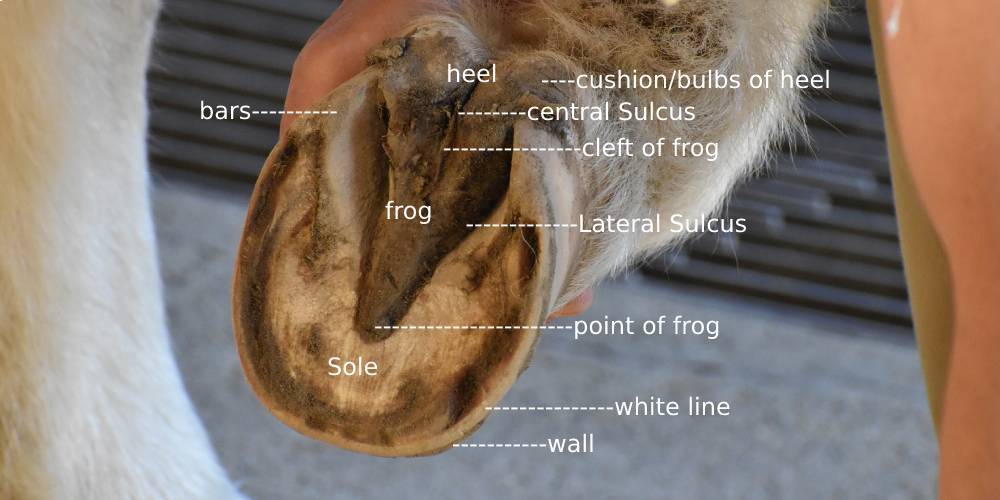After giving my cousin my old horse Cross Fiire, I began to teach her everything she needs to know about horses. One of these was picking out the horse’s feet. I began to point out the different parts of the horse’s hoof to her to help show her where she needed pick out the dirt and so she would know this valuable information. It then hit me that writing a whole article showing and describing each part of the hoof might be helpful to some people.
What Are The Names Of All The Parts Of The Horse’s Hoof?
There are many different parts of the hoof. The complete list of all the hoof parts includes:
- Hoof Bars
- Bulbs Of Heel
- Heel
- Frog
- Point Of Frog
- Cleft Of Frog
- Sole
- Hoof Wall
- White Line
- Lateral Sulci
- Central Sulcus
These are all the visible parts of the hoof. Some of these parts I didn’t even know existed!!
Descriptions and Purposes Of All The Visible Parts Of The Hoof
Hoof Bars
The hoof bars are one of the less obvious parts of a horse’s hoof. The bars are seen on the left and right sides of the frog. The bars are seen just to the side of the heel and bulbs of the heel and next to the hoof’s lateral sulci.
Describing what the bars of the hoof look like and where they are located is really difficult so this visible representation might make it easier to understand the location and appearance of the hoof bars:
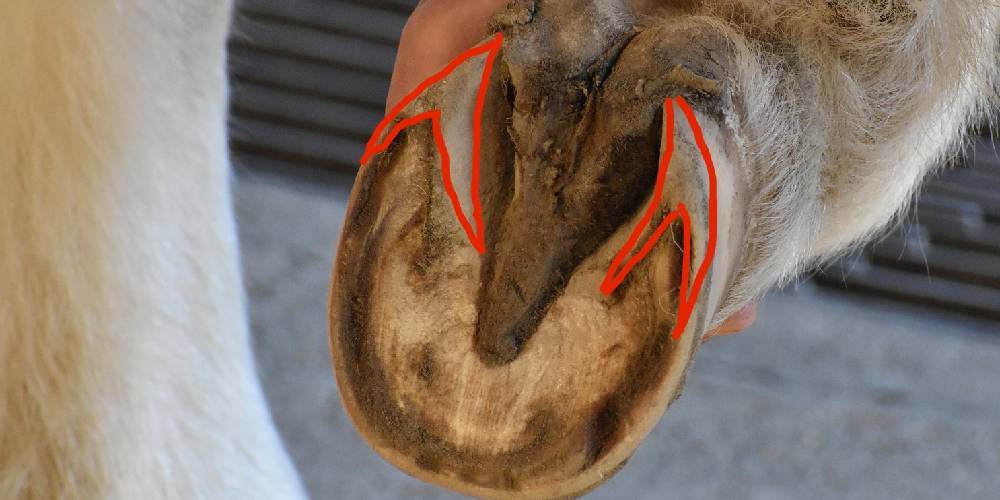
Bulbs Of Heel
The bulbs of the heel are an extremely important part of the horse’s hoof. The reason for this is that the horse’s hoof needs both cushion and protection from the terrain, their weight, and their job. Horses that lack a decent shaped and proper sized heel often suffer from lameness, soreness, and bruising of their hooves due to the lack of protection.
The bulbs of the horse’s heel are at the very backmost part of the horse’s hoof. They are, unlike most of the hoof, made of a softer tissue than that of the sole or the hoof wall. This softer tissue helps to act as a cushion for when the horse moves and their weight falls on their heel. This natural cushion and protection are especially important in sports such as jumping or racing as these sports are especially hard on the horse’s legs and lower body.
Horses, especially horses with physical leg and foot issues, tend to carry most of their weight in their heels. Having a healthy amount of heel growth is important to help cushion and support the horse as they move around and use their legs and lower bodies.
The bulbs of the heel are round and, well, bulbous parts of the hoof seen in the very back of the hoof. A visual example of this might to help to understand what this part of the hoof looks like, and where it falls on the horse.

Heel
The heel of the horse is a crucial part of the horse’s hoof. Like the bulbs of the heel, the heel acts like a cushion to help keep the horse’s feet sound and comfortable while they are moving about.
Many horses don’t really have much heel on their feet which can cause them to be more prone to soundness issues. Horses with these problems should have a plan with their farriers to help encourage more heel growth.
The heel of the horse is in the same place as that of the bulbs of the heel.
Frog
The frog is quite possibly the most well-known part of the horse’s hoof. The frog can be identified as the large triangular-shaped raised portion at the center of the hoof. The frog, like the heel, acts as a cushion for the horse’s hoof to help absorb some of the shocks from jumping, galloping, or even just walking.
Fun Fact: The frog is actually believed to be a sort of blood pump. As the horse steps on it, it helps to push the blood back up out of the horse’s leg back into their body. This is thought to be why neglected horses have such swollen legs as the blood is not being pushed back up to the rest of the body. Though frequent exercise is crucial to the horse’s health and blood flow, it is still debated on whether or not the frog actually acts as a sort of blood pump.
Fun Fact: The frog is one of the most important, and one of the first parts of the hoof to learn.
Fun Fact: Did you know that horses will actually shed off a part of their frog periodically? This is kind of like how us humans shed off our dead skin.
If you don’t know what a frog looks like, this visual might help:

Point Of Frog
The point of the frog is, well, the pointed end of the frog that falls in the middle of the hoof. When a horse sheds off its frog, the point of the frog is actually the first part of the frog to start to come off.
The point of the frog offers cushion all the way in the middle of the horse’s hoof which is extremely helpful for top-level competition horses who need the cushion to help support themselves as they do their intense job. The point of the frog is also a helpful indicator as to where you need to pick out the hoof. When cleaning the hoof you can use this part to see where you need to use the pick: on either side of the frog starting next to the point of the frog.
If you can identify the frog, the point of the frog is easy to see. The point of the frog is just the pointed end of the frog. This visual may help you to identify it:
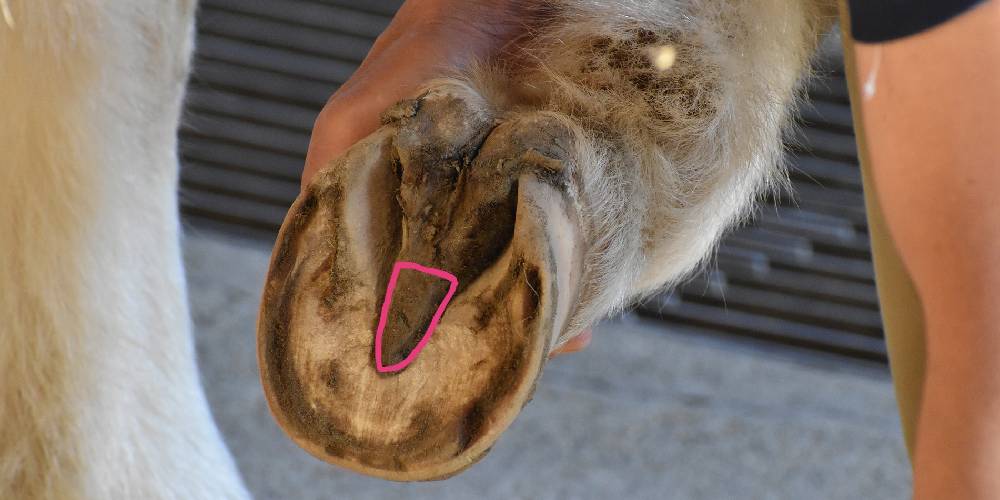
Cleft Of Frog
The cleft of the frog is one of the hoof parts that can be harder to identify. The cleft is just the slight groove in the upper middle part of the frog.
This part of the hoof can be identified by both its location and shape.
Because this isn’t a very well known hoof part, the following image should better be able to show where and what this part is:
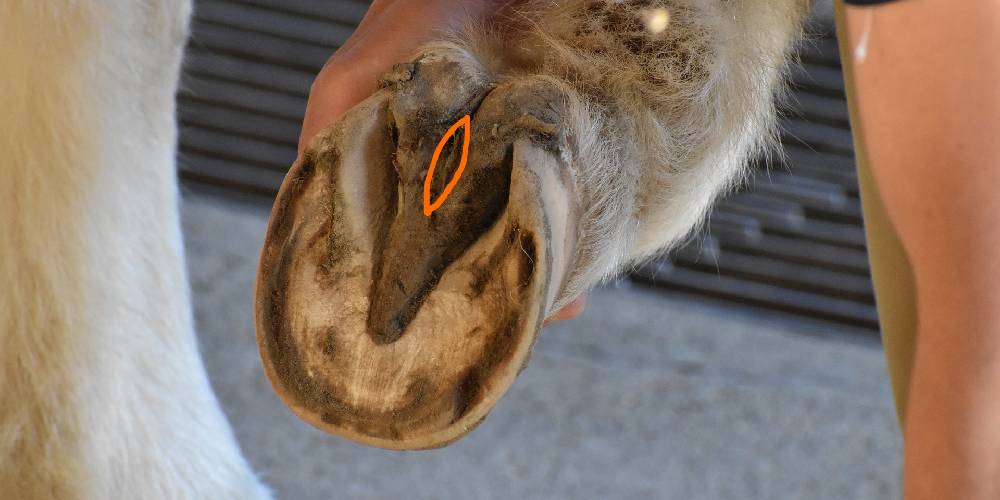
Sole
The sole of the hoof is the large flat portion of the underside of the hoof. The sole is hard and smooth and is seen on the entire part of the hoof’s underside other than where the frog is.
The sole, if the horse is being ridden over rocks or other sharp, rough terrain, is often prone to bruising. My horses actually often suffered this, especially after trail rides, as the ground in my area is extremely hard and rocky.
The sole is usually white in color regardless of the color of the horse, and a hoof knife is used to shorten and level the sole when new shoes and/or trimming is due.
The sole of the horse’s hoof is one of the main places where hoof abscesses can form. These can form through damage from rocks or other sharp objects, the farrier driving a hot nail, or if the horse is suffering from an extreme case of laminitis.
This part of the hoof extends to the white line near the hoof wall.
In the image below, the sole of the hoof is outlined so you can better seen and identify it.
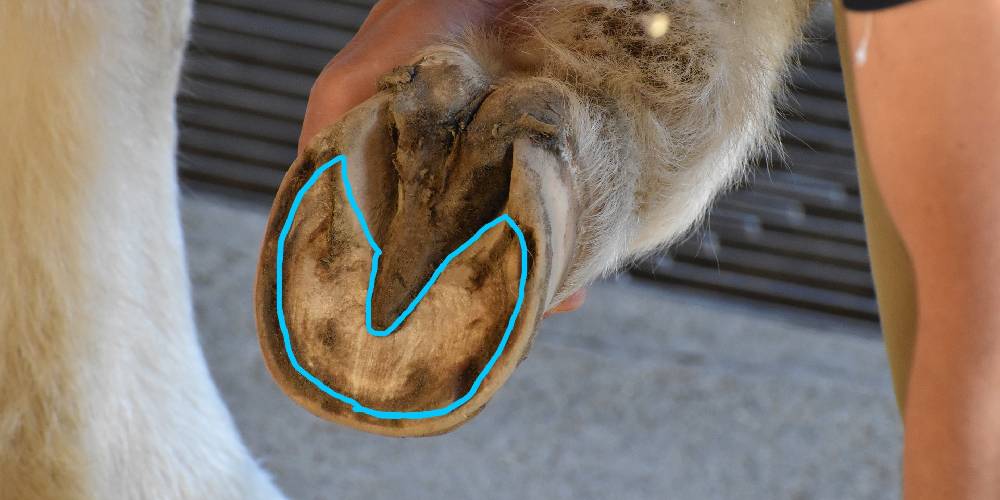
Hoof Wall
The hoof wall is actually a part of the hoof that not only shows on the underside of the hoof, but it also stretches up to encase the entire front and outside of the hoof.
The hoof wall is hard and strong and protects the more sensitive parts of the hoof from injuries by absorbing much of the shock. Think of the hoof wall as hoof armor. Without the hoof wall, the hoof would not be hard or protected at all and lameness issues would be so much more common than they are now.
It is through the hoof wall that a farrier will drive nails to hold a shoe in place. Some people worry that this might hurt the horse, but because the hoof wall is hard and without nerves, no pain is felt from the nails. The only time a horse will feel pain from the nails holding their show on is if the farrier drives a hot nail. A hot nail is where the nail is hit too close to the inside of the hoof and pierces sensitive tissue causing lameness and potential infection and abscess formation.
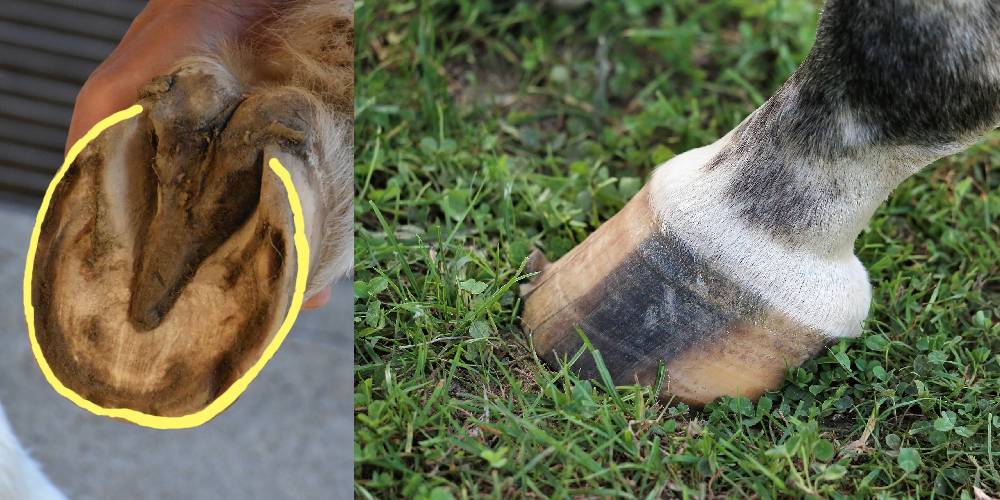
White Line
The white line of the hoof is only visible on the underside of the hoof. If the horse is wearing shoes, the white line will actually be covered and not visible at all. The white line is called the white line because it is a lighter colored line as compared to the hoof wall or any other part of the hoof.
The white line is known to have some complications if not taken care of properly. One of these things is something known as thrush which is a common issue seen not just in the white line, but all over the hoof. Another issue seen in this part of the hoof is something known as white line disease. This disease causes the separation of the hoof wall from the hoof at the white line.
The white line is found just along the hoof wall in between the wall and the sole.
This image might help demostrate where this part of the hoof is.
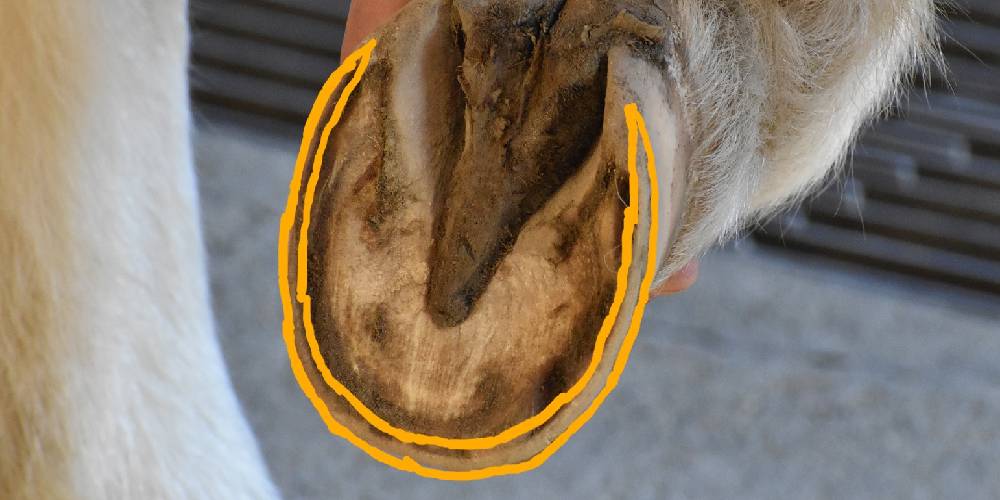
Lateral Sulci
The lateral sulci are well-known parts of the foot, but not many people know what these are called. There are two lateral sucli, one on the left and one on the right of the frog. This is where most of the dirt, rocks, and manure build up in the foot, and it is also the most common place for thrush to occur.
When picking out a horse’s hooves, this is the main part of the hoof that is cleaned out.
The lateral sulci are on each side of the frog, and dip deep into the hoof by about one centimetre to a half of an inch.
Though some may understand what I am talking about, this image should help you get the idea of what I am trying to say:
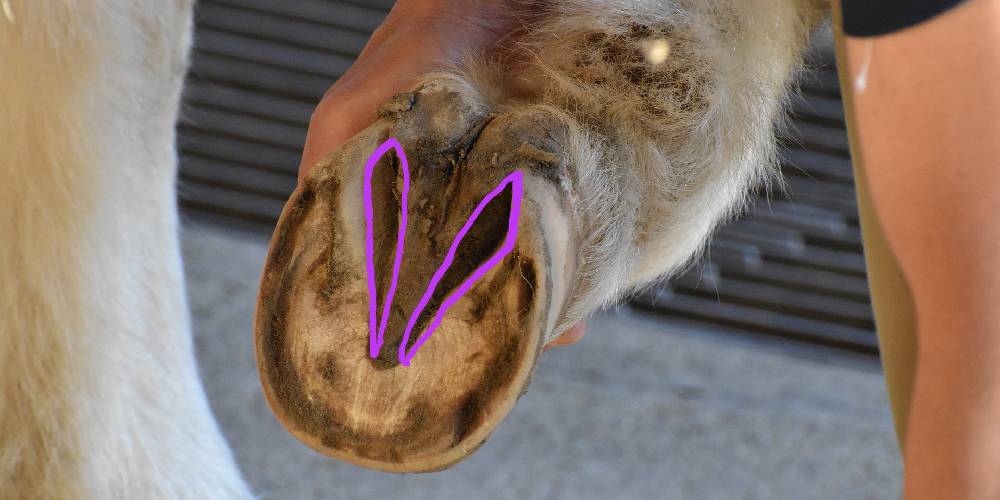
Central Sulcus
The central sulcus can also get dirt, rocks, and other build up inside of it, though this isn’t very common. This sulcus falls at the back of the hoof behind the cleft of the frog and in between the bulbs of the heel.
This part of the hoof isn’t really known to well and, to be honest, I didn’t even know this part of the hoof had a name until I began researching for this article!
This image will help to show you where it is on the horse:
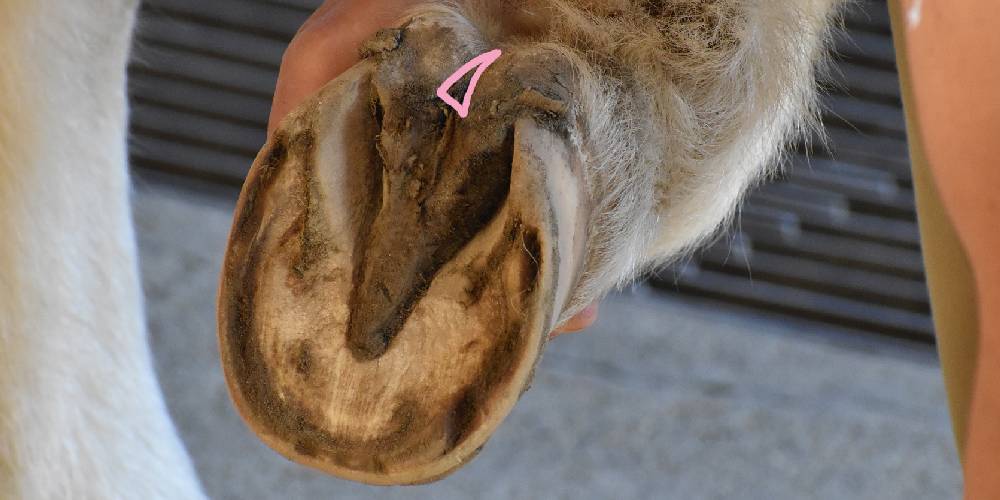
Internal Parts Of The Horse’s Hoof
Not only are there a ton of different parts of the hoof on the outside, but there are also numerous on the inside as well. The hoof is made up and moved by several different bones and tendons.

